In the early 1970s, the U.S. was still in the grips of the cold war. And Western Springs’ new village hall had a special feature that was of interest to mayors and even presidents.
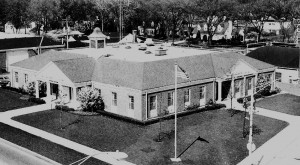
Western Springs’ new Village Hall – circa 1968
The Cuban missile crisis of 1962 brought the world to the edge of nuclear war. While tensions eased over the next ten years, planners were aware that this could change over time. As a result, new public buildings were often constructed with civil defense in mind.
In the case of Western Springs, an emergency operation center was included in the original plans for the village hall.
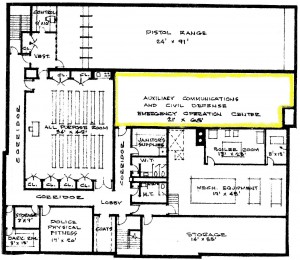
Basement location of proposed emergency control center – 1968
Completed in 1970, the room was 21 feet wide by 68 feet long. It could serve as both a shelter and an auxiliary communications room in the event of a nuclear attack or another disaster. It was described as being radiation-proof and capable of housing upwards of 100 people with food and water supplies sufficient for two weeks. But, the big question was, who would be admitted?
In a 1978 newspaper article, a former village manager acknowledged the existence of the facility and stated that “Western Springs comes first”. But, this did not mean the general population. Instead, because of its relatively small size, access to the shelter would be limited to just certain village officials and their immediate families: the village president, six trustees, village manager, and coordinators for emergency services, public information, fire rescue, law enforcement, medical services, public works, shelter management, military liaison, and radiological issues.
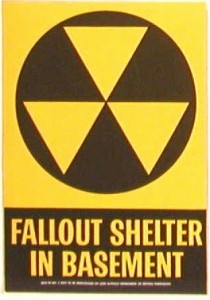
Civil Defense Shelter Sign
In addition, it was reported that armed guards would be posted at the entrances to ensure no one else entered. As expected, this prompted some unfavorable responses from the “excluded” citizenry.
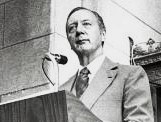
Chicago Mayor Michael Bilandic – 1978
When completed, the center was one of only six federally certified facilities of its type in Cook County. As a result, the City of Chicago wrote to the village concerning its possible use by Mayor Michael Bilandic in the event of a nuclear attack or similar disaster. And, although no formal agreement was put in place, at least one Chicago newspaper, as well as a television station, reported that such an arrangement had been agreed upon. After that, the rumor mill took over.
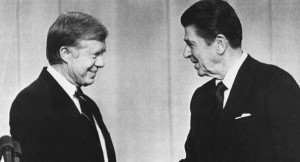
Jimmy Carter (left) and Ronald Reagan – 1980
For a number of years, the center was also on the Secret Service’s list of possible refuge sites whenever the President (first Carter and then Reagan) was in the Chicago area. In fact, Secret Service personnel reportedly visited the village hall prior to each presidential visit to Chicago, just to make sure things were in order. Fortunately, it was never necessary for either of them to use the shelter.
But what became of the bomb shelter? With the decline in cold-war tensions, the space was eventually repurposed into office space for the Public Works Department. Similarly, the police shooting range, also shown in the second photo, was converted into office space for the police and other departments.
